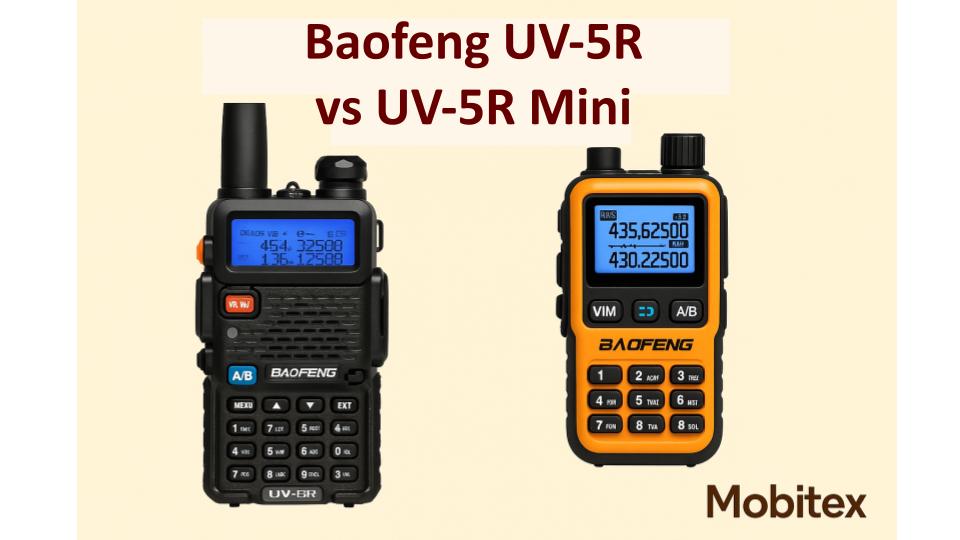Mobitex contains affiliate links and is a member of the Amazon Services LLC Associates Program. If you make a purchase using one of these links, we may receive compensation at no extra cost to you. This helps support our research, testing and writing.
Both radios are wildly popular, budget-friendly dual-band handhelds. They share the same general ecosystem (antenna, audio accessories, chargers, CPS), but they’re not identical. Here’s a clean, practical comparison to help you choose.
TL;DR
- Choose the UV-5R if you want the classic, most-documented first HT with a huge accessory and knowledge base.
- Choose the UV-5R Mini if you want a smaller body, a color screen, far more memory channels, and extra receive coverage—without leaving the UV-5R universe.
🏷️ Baofeng Radio Deals ⭐⭐⭐⭐
At a Glance
| Feature | UV-5R | UV-5R Mini |
|---|---|---|
| Bands (TX/RX) | VHF/UHF | VHF/UHF (+ wider RX coverage) |
| Output power | ~4 W / 1 W | ~5 W / 2 W |
| Memory channels | 128 | 999 |
| Display | Monochrome | Color TFT (≈1.44″) |
| Size & weight | ≈110×58×32 mm; ≈200–250 g | ≈107×52×37 mm; ≈200 g |
| Broadcast FM receive | Yes | Yes |
| Extra RX | — | Often includes AM Airband (108–136 MHz) receive |
| Ecosystem | Massive | Growing (shares much with UV-5R) |
| 💳 Pricing | 💲Check Price | 💲Check Price |
Specs vary slightly by batch/seller; treat values as typical.
Power & Real-World Range
On paper, the UV-5R Mini often lists a slightly higher “High” setting than the classic UV-5R. In the field, antenna, height, terrain, and repeaters dominate your usable range. If you already plan to use a good antenna or a local repeater, the 1 W difference won’t be the deciding factor.
Memory & Channel Management
If you like traveling with big codeplugs (local repeaters, simplex, weather, events), the UV-5R Mini’s 999 channels are a genuine quality-of-life upgrade over the UV-5R’s 128. For simple use (a handful of repeaters and simplex), 128 is plenty.
Size, Ergonomics, and Carry
The Mini trims a bit of width and is slightly shorter. It’s more comfortable for pocket carry or on a shoulder strap all day. The classic UV-5R remains compact, but the Mini’s proportions feel a touch more modern.
Screen & Usability
The UV-5R uses a familiar monochrome display and menu system. The UV-5R Mini adds a color screen that makes status info and menus easier to read at a glance—handy in bright daylight or for newer users.
Receive Coverage
Both radios receive broadcast FM (65–108 MHz). The Mini frequently adds AM airband (108–136 MHz) receive, which is fun and useful if you’re near airports or enjoy aviation listening. Transmit remains on the amateur bands as configured.
Battery & Charging
The UV-5R commonly ships with ≈1800 mAh packs and desktop chargers, with tons of third-party battery options. The UV-5R Mini is often bundled with a slightly larger-capacity pack and the same general charging ecosystem. USB-powered cradles and extended batteries are widely available for both.
Programming & Ecosystem
- UV-5R: The most documented beginner HT out there. Extensive tutorials, codeplugs, accessories, and community support.
- UV-5R Mini: Uses the same general workflow for programming; community profiles and third-party support continue to grow.
Which One Is Right for You?
Choose UV-5R if you want:
- the safest “first HT” with maximum community help and accessory compatibility,
- a rock-solid baseline radio for club, training, or loaner fleets.
Choose UV-5R Mini if you want:
- a smaller, modernized body with a color display,
- 999 channels for bigger codeplugs and travel,
- extra receive coverage (like AM airband) in one pocketable package.
Bottom Line
If your priority is a proven, well-documented starter with endless community resources, the UV-5R is still the easiest recommendation. If you value compactness, a color screen, and big channel capacity—and you like the idea of airband listening—the UV-5R Mini is the better fit.






